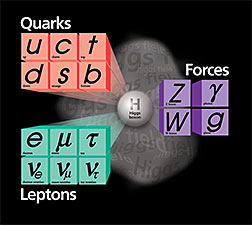- Number 390 |
- June 10, 2013
Looking for the Higgs boson’s big brother

The Standard Model of particles and forces.
Credit: Fermilab.
Last year, experiments at the Large Hadron Collider discovered a new particle that seemed to fit the description of the long-sought Higgs boson. Since then scientists have investigated the particle’s properties in greater detail, and so far all tests confirm that this is the Higgs boson predicted by the theoretical framework known as the Standard Model. More than 1,800 scientists, engineers and graduate students from U.S. institutions collaborate on the LHC experiments.
Even if the new particle gives mass to elementary particles such as electrons and quarks, it may not be acting alone. Nothing forbids the existence of multiple Higgs bosons. Scientists working on the CMS experiment recently published the results of their search for a heavier Higgs particle. This required different search techniques, since a heavy Higgs would decay differently than the already observed light Higgs particle, which has a mass of 125 GeV. The CMS search has yielded the most stringent mass constraints on such a heavy Higgs to date: it rules out the existence of additional Higgs bosons with a mass below 710 GeV.
The search for extra particles will go on. Scientists expect to discover in the 100 – 1000 GeV range more particles that help explain the symmetry breaking between the weak and electromagnetic forces. When the LHC restarts in 2015, it will give scientists access to more data and higher collision energies.[Kurt Riesselmann, 630.840.3351,
kurtr@fnal.gov]
